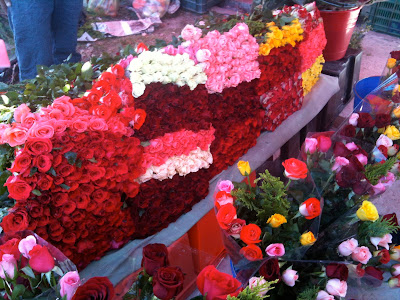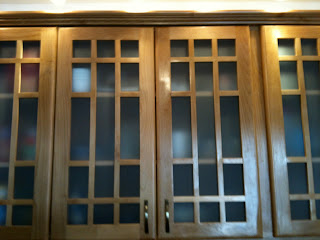Barrel cactus flowers
Here in Mexico we are drawing to the end of the political campaign, which has several features that I as an American am envious of. For one, the campaign is limited to the two months preceding the July 1 vote, this Sunday. The campaigning is therefore more intense than in the US, but at least it doesn't drag on forever as ours seems to. I also like the fact that here the president can legally serve only one six-year term: no concern about being re-elected and with six years it should be possible to get something done. The current president, Felipe Calderón, has focused on overcoming the drug trafficking and consequent violence, but he doesn't seem to have been very successful. The simplest solution would be for Americans to stop buying drugs, but of course that won't happen.
This being Mexico, there are a couple of things different about political campaigns. First is the noise. There are many demonstrations, parades, and sound trucks blaring slogans and candidates' names, all very loud of course. Because Mexico is such a communal place with people in the streets and socializing on front stoops, there is a lot of citizen participation in the campaigns. Parades such as the one below, for a man running for governor of Guanajuato State, have been common.
I asked a man in the parade who was wearing a T-shirt of another candidate why he liked that candidate. "Es lo mejór!" he answered enthusiastically. "He's the best!"
The entire town is simply festooned with campaign signs on every available surface. Because there are walls everywhere -- houses, remember, are built within walls, something I have come to love for the privacy -- the walls serve as perfect surfaces for campaign signs. Some of them, like the next one, have letters that are big enough to be seen from outer space.
And as you'd expect with political feelings running high, sometimes people express their oppositional feelings pretty directly.
I suspect the candidates are far more motivated to paint all these walls at the beginning of the campaign than to restore them to their original state when it's over. I guess everyone will have to look at these things until the next campaign.
Every single lamp post in town has at least one campaign poster attached to it. By now, near the end of the campaign, a number of them have been torn or defaced by opponents' supporters. And this gives the candidates an opportunity to use the destruction of their campaign materials as an argument for their own virtue and the lack of same among their opponents. It's looking pretty ragged around here.
Yesterday three men were killed in Chiapas, a state in the south of Mexico next to Guatemala. Drugs, I assumed. But no: they were three men who were having a political argument defending their candidates and opposing the candidates of the other two, and the argument got pretty heated. A Mexican told me this happens every election, with people killing each other in political disagreements. Can you imagine Americans caring that much about politics? I can't.
Perhaps not by coincidence, the campaign materials of the sole woman running for president among four candidates are not nearly as ubiquitous as those of the others. Josefina Vazquez Mota is trailing in the polls partly because she's from the same political party as Calderón, the PAN, and he's not very popular.
The word on the street is that Enrique Peña Nieto, the candidate of the PRI party that ruled Mexico for over 70 years until 2000, will be elected president. A handsome man + a beautiful wife + a lot of money = electability, but he represents a party that was known for its authoritarianism. We will see.
I have been busy getting the casita ready for the first renter, who is arriving on Monday for a two-month stay. I have bought furniture, pictures, an area rug, and kitchen supplies. I have had two futons Rick left behind cleaned, and a bookcase built by the same carpenter who did all the gorgeous woodwork in both houses. I have had the walls painted, so they are no longer white: a buttery cream in the bedroom and bath, and a soft apricot in the kitchen and living room. It is looking quite beautiful. While she is here I will be looking for another renter, preferably long-term, to succeed her. As you can imagine, it will take months and months for all these expenditures to be made up, but it is necessary and will eventually pay off.
I am sorry but I have not yet taken photos of Rick's new house. I promise I will! He has bought the house he had his heart set on, and has gotten a marvelous deal on it. He has a much larger house now than he had here: a living room, an eat-in kitchen, a small solarium, three bedrooms and three baths, as opposed to one and one in the casita. His house has a shady front courtyard and a large, sunny, tiled upstairs patio. He will be able to rent out a bedroom for additional income because there are stairs from the courtyard to the second floor, making it a private entrance. The house is six or seven blocks from here in the same neighborhood, so he and I are back and forth all the time. He moved there two weeks ago. At first it felt sort of creepy being alone in this big place all by myself, but I am now completely used to it. When the renter is here, will it feel crowded?
Rick has been writing quite a lot of poetry, and I like most of it very much. I think he is pretty astonished to be finding this gift in himself at this point of his life, but he is loving it. On most Tuesday evenings, he reads some of his poetry at an Open Mic night where people perform poetry, prose, music, and dance. People have asked him where they can buy a copy of his poetry books! Here is a poem he wrote:
FOR A PESO
As I was walking the streets of San Miguel
I saw a twisted old woman
Half sitting, half lying on the sidewalk
I stopped to drop a peso in her basket
As I bent down, she looked up
Eyes probing mine, pulling me
Into her very being
Did I see the mother she had once been,
Her children now scattered and lost to her?
Had she once been someone's bride?
Some young man's passion?
Had her body always been broken?
Or had she run with her friends
Laughing in the sun?
Had she ever been carefree, giggling,
Sharing her dreams and longings?
Had she held the hands of her brothers and sisters
As they skipped across the plaza?
In her long life, had she ever felt safe,
Sheltered, and wholly loved?
Then, I saw in those eyes
That she had been all those things.
Was all those things.
Is all those things.
And, as I finally released the coin
Into her basket — she smiled
The sweetest smile, said "Gracias"
And released me to my passing self.
Rick has been writing, and I have been editing. A friend here, Richard Gordon, has written and self-published a book called Butterfly Zen. It is a marvelous book, an allegory about two butterflies and other creatures who serve as the vehicle for Richard's hard-won life wisdom, while being three-dimensional characters in their own right. I find Richard extraordinarily wise and thoughtful, and am so happy he's found a creative way — a way that works! — to express it. When I ordered my copy and read it, I saw that he is a better thinker and writer than he is knowledgeable about punctuation and other picky but important things. I offered to edit it, so he and I are spending hours every week going over the book word by word to improve it. You understand that I wouldn't spend this kind of time if I didn't think the book was worth it. I've done a lot of editing before but never with the author directly, so it's an interesting experience for me. If you'd like to read Richard's book, let me know by email (jo@josanders.com) and I'll tell when the edited version is available for purchase online.
The deadline for applications from instructors to teach a course in my adult education program, which will be piloted for the month of October, is two days from now. So far I have received two applications, both quite good: a history of Mexico and an introduction to architecture. I hope there will be more applications because I'd like to have a choice. It's all a learning experience.
The rains have come, finally, putting an end to temperatures in the low- to mid-90s. It's astonishing how immediately the temperatures come down 10 degrees (F.). Now it's not too hot to go to the Tuesday Market, the main market that attracts vendors of foods and every sort of merchandise imaginable, from miles around. I wanted to take pictures of many stalls — so many are so beautiful! — but here are just two of them for you, plastic shopping bags and roses. A dozen roses, by the way, cost 25 pesos, or $1.85. A big ripe sweet pineapple cost 13 pesos, or just under a dollar.
Hasta luego!
Jo
















































